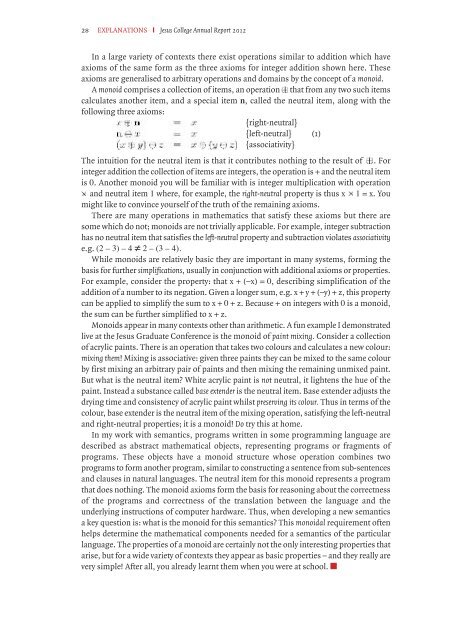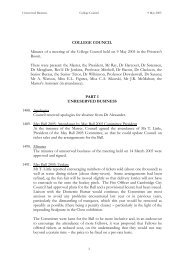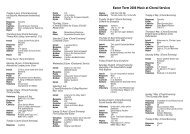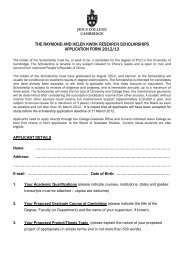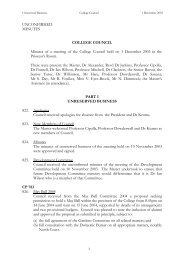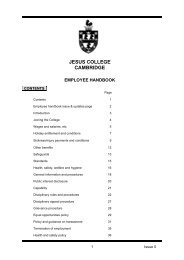2012 Annual Report - Jesus College - University of Cambridge
2012 Annual Report - Jesus College - University of Cambridge
2012 Annual Report - Jesus College - University of Cambridge
You also want an ePaper? Increase the reach of your titles
YUMPU automatically turns print PDFs into web optimized ePapers that Google loves.
28 EXPLANATIONS I <strong>Jesus</strong> <strong>College</strong> <strong>Annual</strong> <strong>Report</strong> <strong>2012</strong><br />
In a large variety <strong>of</strong> contexts there exist operations similar to addition which have<br />
axioms <strong>of</strong> the same form as the three axioms for integer addition shown here. These<br />
axioms are generalised to arbitrary operations and domains by the concept <strong>of</strong> a monoid.<br />
A monoid comprises a collection <strong>of</strong> items, an operation that from any two such items<br />
calculates another item, and a special item n, called the neutral item, along with the<br />
following three axioms:<br />
x _ n = x {right-neutral}<br />
n _ x = x {left-neutral} (1)<br />
(x _ y) _ z = x _ (y _ z) {associativity}<br />
The intuition for the neutral item is that it contributes nothing to the result <strong>of</strong> . For<br />
integer addition the collection <strong>of</strong> items are integers, the operation is + and the neutral item<br />
is 0. Another monoid you will be familiar with is integer multiplication with operation<br />
and neutral item 1 where, for example, the right-neutral property is thus x 1 = x. You<br />
might like to convince yourself <strong>of</strong> the truth <strong>of</strong> the remaining axioms.<br />
There are many operations in mathematics that satisfy these axioms but there are<br />
some which do not; monoids are not trivially applicable. For example, integer subtraction<br />
has no neutral item that satisfies the left-neutral property and subtraction violates associativity<br />
e.g. (2 – 3) – 4 ≠ 2 – (3 – 4).<br />
While monoids are relatively basic they are important in many systems, forming the<br />
basis for further simplifications, usually in conjunction with additional axioms or properties.<br />
For example, consider the property: that x + (–x) = 0, describing simplification <strong>of</strong> the<br />
addition <strong>of</strong> a number to its negation. Given a longer sum, e.g. x + y + (–y) + z, this property<br />
can be applied to simplify the sum to x + 0 + z. Because + on integers with 0 is a monoid,<br />
the sum can be further simplified to x + z.<br />
Monoids appear in many contexts other than arithmetic. A fun example I demonstrated<br />
live at the <strong>Jesus</strong> Graduate Conference is the monoid <strong>of</strong> paint mixing. Consider a collection<br />
<strong>of</strong> acrylic paints. There is an operation that takes two colours and calculates a new colour:<br />
mixing them! Mixing is associative: given three paints they can be mixed to the same colour<br />
by first mixing an arbitrary pair <strong>of</strong> paints and then mixing the remaining unmixed paint.<br />
But what is the neutral item? White acrylic paint is not neutral, it lightens the hue <strong>of</strong> the<br />
paint. Instead a substance called base extender is the neutral item. Base extender adjusts the<br />
drying time and consistency <strong>of</strong> acrylic paint whilst preserving its colour. Thus in terms <strong>of</strong> the<br />
colour, base extender is the neutral item <strong>of</strong> the mixing operation, satisfying the left-neutral<br />
and right-neutral properties; it is a monoid! Do try this at home.<br />
In my work with semantics, programs written in some programming language are<br />
described as abstract mathematical objects, representing programs or fragments <strong>of</strong><br />
programs. These objects have a monoid structure whose operation combines two<br />
programs to form another program, similar to constructing a sentence from sub-sentences<br />
and clauses in natural languages. The neutral item for this monoid represents a program<br />
that does nothing. The monoid axioms form the basis for reasoning about the correctness<br />
<strong>of</strong> the programs and correctness <strong>of</strong> the translation between the language and the<br />
underlying instructions <strong>of</strong> computer hardware. Thus, when developing a new semantics<br />
a key question is: what is the monoid for this semantics? This monoidal requirement <strong>of</strong>ten<br />
helps determine the mathematical components needed for a semantics <strong>of</strong> the particular<br />
language. The properties <strong>of</strong> a monoid are certainly not the only interesting properties that<br />
arise, but for a wide variety <strong>of</strong> contexts they appear as basic properties – and they really are<br />
very simple! After all, you already learnt them when you were at school. ■


